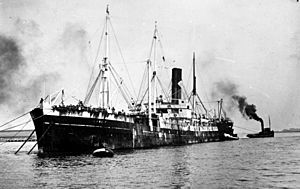SS Lancing facts for kids
class="infobox " style="float: right; clear: right; width: 315px; border-spacing: 2px; text-align: left; font-size: 90%;"
| colspan="2" style="text-align: center; font-size: 90%; line-height: 1.5em;" | 
|} The SS Lancing was a large ship that started its life as a British cargo ship named Knight Errant. Over the years, it had many different owners and names, including Rio Tiete, Omsk, Calanda, and Flackwell. Eventually, it became a Norwegian whale factory ship. Sadly, the Lancing was sunk by a German submarine, the U-552, on April 7, 1942, near Cape Hatteras during World War II.
Contents
| History | |
|---|---|
| Name |
|
| Owner |
|
| Builder | Charles Connell and Company, Scotstoun |
| Yard number | 240 |
| Launched | 11 December 1897 |
| Completed | 1898 |
| Fate | Sunk on 7 April 1942 |
| General characteristics | |
| Class and type |
|
| Tonnage |
|
| Length | 470 ft (143.26 m) |
| Beam | 77 ft 3 in (23.55 m) |
| Depth | 31 ft (9.45 m) |
| Propulsion | |
|
Lancing (shipwreck)
|
|
| Lua error in Module:Location_map at line 420: attempt to index field 'wikibase' (a nil value). | |
| Location | Address Restricted, near Buxton, North Carolina |
| Area | 0 acres (0 ha) |
| Built | 1898 |
| Architectural style | Converted Whale Factory Ship |
| MPS | World War II Shipwrecks along the East Coast and Gulf of Mexico |
| NRHP reference No. | 13000451 |
| Added to NRHP | 26 June 2013 |
Building and Early Life at Sea
The ship, first called Knight Errant, was built by Charles Connell and Company in Scotstoun, Scotland. It was launched into the water on December 11, 1897, and finished being built the next year.
The Knight Errant began its work as a cargo ship for the Knight Steamship Company in Liverpool. In 1913, it was sold and renamed Rio Tiete. During World War I, it sailed under the British flag for a while.
Many Names and Owners
In 1915, the ship was sold again to a Russian group called Dobroflot and was renamed Omsk. After the Russian Revolution in 1917, the British government took control of the Omsk.
The ship was sold several more times in the early 1920s. It was renamed Calanda and then Flackwell. Finally, in 1925, a Norwegian company bought the ship. They changed it into a special kind of ship called a whale factory ship and gave it its last name, Lancing.
The Sinking of the Lancing
In April 1942, during World War II, the Lancing was sailing from Curaçao to New York City. It was carrying a huge amount of fuel oil, about 8,900 tons.
On April 7, 1942, a German submarine, the German submarine U-552, spotted the Lancing near Cape Hatteras. The submarine fired a torpedo at 10:52 AM. The torpedo hit the Lancing, and sadly, one crew member died. The rest of the crew quickly left the ship as it began to sink.
The Lancing sank off the coast near Buxton, North Carolina. The surviving crew members were soon rescued by an American oil tanker called the SS Pan Rhode Island.
Later Discovery
Years later, from 2011 to 2013, experts from the National Oceanic and Atmospheric Administration (NOAA) studied the shipwreck. They wanted to see if the sunken Lancing might cause any oil pollution. In 2013, the wreck of the Lancing was added to the National Register of Historic Places. This means it's an important historical site.

